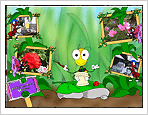 |
Connected Gardens: Timelapse
Wondercasting

PIs: Norm Lownds, Carrie Heeter
Team: Brian Winn, Pete Maziak, Laura Portwood-Stacer, Jason Tye
The Connected Gardens Project is funded by the
Dow Foundation. The full proposal can be viewed by clicking
here.
WONDERCASTING
This summer and fall we are working to create "Children's Garden
Wondercasts." This will be a monthly series of up to four timelapse
photography sequences featured in each wondercast. Our wondercast
anchorperson is a bee. Reporters include worm, ant, caterpillar,
and butterfly. In the first month we'll be looking at a flower as
it comes into bloom, a weathercam showing the ground and sky, shadows
in the garden over time, and a plant's eye view looking out at visitors
to the garden as they look closely at a plant.
As we looked at other people's time lapse movies,
we realized that time lapse is usually presented without clear visualization
of how much time is passing. You see something in fast motion, but
you really don't have a sense of how fast. So, we are implementing
an analog clock to show hours and minutes passing. And we are working
on an equivalent familiar calendar view to show days and weeks passing.
An analog clock (with moving hands) gives a much stronger feel for
time passing than a digital clock where different numbers flash.
Our calendar needs to have the same visceral impact.
In addition to experiencing the passage of time,
our interface will let kids control time. They can play, rewind,
step forward or back, and even drag at their own speed through time,
controlling the visual display, clock, and calendar. Our wondercasts
begin with the reporter asking "Wonder Questions," fascintating
things to look for and think about while exploring the timelapse.
As we progress in the project, we will also experiment with interfaces
where kids can compare two timelapses, and can link time in the
timelapse to other time-based data such as temperature or sunlight.
Our timelapse viewer will eventually be a tool
other gardens and classrooms can modify and use themselves. It will
be possible to input your own images, time, and day data and use
the viewer to control your own time lapse movie. Participating schools
and gardens will be welcome to submit guest "wondercast"
reports for inclusion in our monthly series. All of the time lapses
will be archived, so they are available any time, not just in the
month they were featured.
MARS GARDEN
In Spring, 2002, Lownds and the Comm Tech Lab worked with 69 sixth
graders and one third grade class to conduct prototypical plant
growth experiments using simulated Mars dirt from NASA Ames Research
Center. NASA's goal is to learn the minimum requirements to grow
a plant on Mars. In addition, the participating classes learned
about the process of scientific experiments in a fun, meaningful
context while conducting real research. This work resulted in starting
the Galactic Garden Virtual Laboratory project.
KIDS' TOUR
Last year, in addition to the many field trips and programs Norm
Lownds administered, the Connected Gardens Project produced the
spatial
Kids Tour of the Michigan 4H Children's Garden, a model of elegant
integration of virtual and real worlds, visually rich, filled with
interactivity, explorations, stories, garden sign language, other
fun learning experiences for K-6, and tips for teachers, deeply
integrated with the real garden. This completed project is described
in more detail under PRODUCTS.
|
 |

